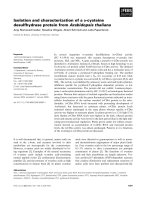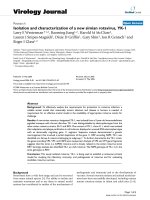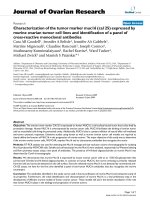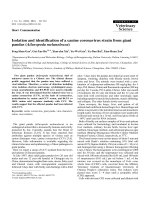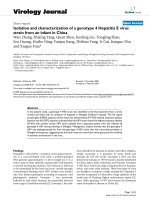Isolation and identification of corynebacterium jeikeium from synovial fluid of a joint Ill affected calf
Bạn đang xem bản rút gọn của tài liệu. Xem và tải ngay bản đầy đủ của tài liệu tại đây (537.21 KB, 6 trang )
Int.J.Curr.Microbiol.App.Sci (2019) 8(9): 2875- 2880
International Journal of Current Microbiology and Applied Sciences
ISSN: 2319-7706 Volume 8 Number 09 (2019)
Journal homepage:
Original Research Article
/>
Isolation and Identification of Corynebacterium jeikeium from Synovial
Fluid of a Joint Ill Affected Calf
Nair Aswathy1, P. M. Priya1*, R. Ambily1, E. Niyas2,
Sudheesh S. Nair3, Rinsha Balan1 and M. Mini1
1
Department of Veterinary Microbiology, College of Veterinary and Animal Sciences,
Mannuthy, Thrissur, Kerala, India
2
ULFFRDS, College of Veterinary and Animal Sciences, Mannuthy, Thrissur, Kerala, India
3
Department of Veterinary Surgery and Radiology, College of Veterinary and Animal
Sciences, Mannuthy, Thrissur, Kerala, India
*Corresponding author
ABSTRACT
Keywords
Calf, Corynebacterium
jeikeium, joint ill,
polymerase chain
reaction, rpo B gene
Article Info
Accepted:
24 August 2019
Available Online:
10 September 2019
Corynebacterium sp. is a Gram-positive, non-motile and facultatively anaerobic bacilli
present in the environment as ubiquitous organism. A 45 day-old Holstein Friesian calf
from University Livestock Farm (ULF), Kerala Veterinary and Animal Sciences
University, Mannuthy was reported with joint ill in both of its forelimbs. Using aseptic
procedures, synovial fluid was collected from the right knee joint and inoculated on to
blood agar and incubated at 37⁰ C for 24 to 48 hrs to isolate and identify the bacterial
aetiology involved. Pin-point gray colonies with hazy haemolysis could be observed. On
Gram’s staining, Gram-positive bacilli with palisade arrangement could be observed. On
sub culturing on to Potassium tellurite blood agar, black coloured colonies suggestive of
Corynebacterium sp. was observed. Biochemical tests were performed both by
conventional method and using Vitek system and the organism was identified as
Corynebacterium jeikeium. On antibiotic sensitivity test (ABST), the organism was found
to be highly sensitive to gentamicin, and highly resistant to ampicillin. For molecular
confirmation, rpo B gene specific polymerase chain reaction (PCR) was performed and an
expected 452 bp amplicons was obtained. Hence, the present case reports the isolation and
characterisation of Corynebacterium jeikeium from a case of joint ill in a calf using
conventional and molecular methods.
Introduction
Joint ill, a suppurative polyarthritis condition
is one of the major causes of calf mortality in
the age group of one week to one month
(Bagga et al., 2009). As explained by Abdulla
et al., (2015), the severe inflammation of the
affected joints as a sequel of infection from
umbilicus and its associated structures led to
critical lameness in young farm animals.
Commonly, the joint ill is observed in
neonatal
period
due
to
unhygienic
environmental conditions of the calving shed
and improper umbilical cord asepsis
(Radostitis et al., 2007). Some of the implied
causes of joint ill in calves include
2875
Int.J.Curr.Microbiol.App.Sci (2019) 8(9): 2875- 2880
Trueperella
pyogenes,
Fusobacterium
necrophorum, Staphylococcus spp., etc. Other
causes of synovitis and arthritis in cattle
include Mycoplasma bovis, Brucella abortus,
etc.
Corynebacterium
spp.
are
ubiquitous
organisms present in the environment, which
are Gram-positive bacilli, non-motile and
facultative anaerobic in nature. It is a common
habitant in the mucous membrane and skin of
the animals (Markey et al., 2013). The
morphology has been described as a typical
Chinese letter like arrangement (Indranil,
2013). Most commonly C. bovis isolates were
observed to cause various pathological
conditions like mastitis, polyarthritis etc. C.
jeikeium was rarely isolated from bovine and
has been reported to cause mastitis in cattle
(Watt et al., 2000). So far, no published
reports have found on the fact that it could
cause arthritis in cattle. The present study
reports the identification of C. jeikeium from a
polyarthritis case.
Materials and Methods
Collection of Synovial Fluid
A 45 day-old Holstein Friesian calf (Fig. 1)
from University Livestock Farm (ULF),
Kerala Veterinary and Animal Sciences
University, Mannuthy was reported to be
suffering from joint ill in both of its forelimbs.
Using aseptic procedures, the synovial fluid
was collected from the right knee joint.
Isolation and Identification of the Bacterial
Agent
The sample was inoculated on to 5 to 10 %
blood agar (BA) and incubated at 37⁰ C both
aerobically and micro aerobically for 24 to 48
hrs. Selective isolation was done by subculturing onto Potassium tellurite blood agar
and incubated at 37°C for 24 to 48 hours.
Isolates were presumptively identified based
on colony morphology, Gram’s staining and
biochemical tests and further confirmed by
genus specific PCR. The biochemical tests
include catalase, oxidase, IMViC (Indole,
Methyl red, Voges- Proskauer and Citrate),
urease and sugar fermentation tests. Vitek
system was used for the confirmation of at
species level.
Molecular Confirmation by PCR
The DNA was extracted by boiling and snap
chilling method (Suresh et al., 2018).
Molecular confirmation at genus level of the
isolate was done by PCR using the primers
targeting rpo B gene (Khamis et al., 2004).
PCR assay was optimized with 12.5 μl
reaction mixture containing 3 μl of DNA
template, 6.25 μl of 2 X master mix (Taq
Green Master Mix, Emerald), 1 μl each of
forward and reverse primers (10 pmol/μl)
(Table- 1) and the rest of the volume is made
by adding nuclease free water. The cycling
conditions
were
as
follows:
initial
denaturation at 95°C for 2 min; 35 cycles of
94°C for 30 sec, 51.4°C for 30 sec and 72°C
for 2 min and a final elongation step at 72°C
for 10 min. The PCR products were subjected
to gel electrophoresis using 1.5% agarose with
ethidium bromide as fluorescent dye and
visualized using gel documentation unit
(Biorad, USA).
Antibiotic Sensitivity Test (ABST)
The procedure of ABST was followed as per
the guidelines established by Clinical and
Laboratory Standards Institute (CLSI, 2015)
with minor modification. The sensitivity of the
isolate was tested in Muller Hinton agar
against 15 selected antibiotics disc of HiMedia, Mumbai (Table-2). The antibiotics
were selected based on the interest of the large
animal practitioners to treat joint ill infected
calves in studied farms. Measurement of the
2876
Int.J.Curr.Microbiol.App.Sci (2019) 8(9): 2875- 2880
growth inhibition zone permitted the
classification of each isolates as sensitive,
intermediate and resistant according to data
provided by Oxoid Ltd., Basingstoke,
Hampshire, England and CLSI (2015).
Results and Discussion
Small, greyish white, hazy haemolytic
colonies were observed on blood agar (Fig. 2).
On Gram’s staining, the isolate revealed
Gram- positive bacilli with Chinese letter
arrangement which was in agreement with
Indranil, (2013). The black colony appearance
on potassium tellurite agar (Fig. 3) and the
other biochemical characters matched with the
findings observed by Barrow and Feltham
(1993) which supported for the confirmation
of Corynebacterium jeikeium.
The isolates could ferment sugars like glucose
and maltose but showed negative results for
lactose, salicin, mannitol, sucrose, trehalose
and xylose (Fig. 4). Based on the primary and
secondary identification, the organism was
identified as Corynebacterium jeikeium.
Species confirmation was done using Vitek
system.
The PCR was standardised for the
identification of Corynebacterium spp. The
amplicon size by targeting the gene rpo B
obtained was 434 bp (Fig. 5) which was
supported by the research done by Khamis et
al., (2004). Corynebacterium jeikeium was
isolated from the present study but Goodarzi
et al., (2015) could isolate 20 per cent
Corynebacterium bovis from the polyarthritic
samples Corynebacterium spp. was observed
as a common habitant of the skin and mucous
membrane of animals by Markey et al., 2013.
Watt et al., (2000) could isolate
Corynebacterium jeikeium from mastitis
affected cattle. Hence it could be concluded
that the organism might caused joint ill in the
present study as an outcome of cross
contamination from the mastitis affected
cattle.
Table.1 Details of the Primers
Primer
Rpo F
Rpo R
Sequence
5’-CGWATGAACATYGGBCAGGT-3’
5’TCCATYTCRCCRAARCGCTG- -3’
Amplicon size
434 bp
Table.2 List of antibiotic discs and their concentration
Sl. No.
1
2
3
4
5
6
7
8
9
10
11
12
13
14
15
Name of antibiotic discs
Gentamicin (G)
Ceftriaxone (CTR)
Tetracycline(T)
Penicillin (P)
Cefalexin (CN)
Amoxyclav (AMC)
Enrofloxacin (EX)
Amoxycillin (AMX)
Streptomycin (S)
Amikacin (AK)
Ceftriaxone/ Sulbactam (CIS)
Ceftriaxone/ Tazobactam (CIT)
Cefuroxime (CXM)
Cefotaxime (CTX)
Ampicillin
2877
Concentration
30 µg
30 µg
30 µg
10 Units
30 µg
30 µg
10 µg
30 µg
25 µg
30 µg
30 µg
30 µg
30 µg
30 µg
10µg
Int.J.Curr.Microbiol.App.Sci (2019) 8(9): 2875- 2880
Fig.1 Calf showing inflammation on both the knee joint
Fig.2 Greyish white colonies with hazy haemolysis on BA
Fig.3 Black coloured colonies on Potassium tellurite agar
2878
Int.J.Curr.Microbiol.App.Sci (2019) 8(9): 2875- 2880
Fig.4 Sugar fermentation tests of Corynebacterium jeikeium
1
2
3
4
5
6
7
8
1) Control; 2) Mannitol; 3) Salicin; 4) Trehalose
5) Maltose; 6) Lactose; 7) Sucrose; 8) Glucose
500 bp
434 bp
100bp
Fig. 5 PCR amplification of rpoB gene of
Corynebacterium spp.
Lane 1- 100 bp Ladder
Lane 2, 5 and 6- Negative isolates
Lane 3 - Positive control
Lane 4- Positive isolate
The results of ABST revealed the organism
was sensitive to gentamicin, tetracycline,
enrofloxacin, amikacin and streptomycin;
intermediate sensitive to penicillin-G,
ceftriaxone/ tazobactam, cefuroxime and
cefotaxime and resistant towards ampicillin,
ceftrixaone, cefalexin, amoxyclav and
amoxycillin.
Corynebacterium jeikeuim is rarely isolated
from bovine but reports have found on that
isolates could cause mastitis in cattle but rare
or almost nil reports have found on the fact
that it could cause arthritis in cattle. The
isolation of Corynebacterium jeikeium from a
case of joint ill in a calf using conventional
and molecular methods is highlighting the
2879
Int.J.Curr.Microbiol.App.Sci (2019) 8(9): 2875- 2880
importance of maintaining calving shed
hygiene, naval asepsis and timely treatment of
infected calves.
Acknowledgement
The authors are thankful to the Dean, College
of Veterinary and Animal Sciences,
Mannuthy
for
providing
necessary
infrastructure for the study.
References
Abdullah, F. F. J., Sadiq, M. A., Mohammed,
K., Tijjani, A., Abba, Y., Chung, T. L.
E., Adamu, L., Osman, A. Y., Lila, M.
A. M., Haron, A. W. and Saharee, A. A.
2015. A clinical case of Navel ill in a
calf: Medical management. Int. J.
Livestock Res. 5: 103-108.
Bagga, A., Muralidhara, A. and Ravindarnath,
B. M. 2009. Joint and navel ill
association and its treatment in five
calves - A clinical study. Intas Polivet.
10: 204-206.
Barrow, C. I. and Feltham, K. K. A. 1993.
Co-identification of medical bacteria.
(2nd Ed.). Cambridge University Press,
USA, 331p.
Goodarzi, M., Khamesipour, F., Mahallati, S.
F., Dehkordi, M. K. and Azizi, S. 2015.
Study on prevalence of bacterial causes
in calves arthritis. J.Asian Res.
Publishing Network. 10: 206-212.
Indranil, S. 2013. Veterinary bacteriology. (1st
Ed.). New Indian publishers, New
Delhi, 377p.
Jalal, M. S., Dutta, A., Islam, K. M. F.,
Sultana, J., Sohel, M. S. H. and Ahad,
A. 2016. A study on the prevalence and
etiology of joint ill in calves of cross
breed dairy cattle in six dairy farms of
Bangladesh. Res. J. Vet. Pract. 4: 66-70.
Khamis, A., Raoult, D. and Scola, B. 2004.
rpoBGene sequencing for identification
of Corynebacterium species. J. Clin.
Microbiol.19: 3925-3931.
Markey, B. K., Leonard, F.C., Archambault,
M., Cullinae, A. and Maguire, D. 2013.
Clinical Veterinary microbiology. (2nd
Ed.). Elsevier, St. Louis, 1476p.
Radostits, O. M., Gay, G. C., Hinchcliff, K.
W. and Constable, P. D. 2007.
Veterinary Medicine-A Text book for
the Diseases of Cattle, Sheep, Pigs,
Goats and Horses. (10th Ed.). Saunders
Elsevier, St. Louis, 645p.
Suresh Y, Subhashini N, Kiranmayi CB,
Srinivas K, Ram VP, Chaitanya G.
2018.
Isolation,
Molecular
characterization
and
antimicrobial
resistance patterns of four different
Vibrio species isolated from fresh water
fishes. Int. J Curr. Microbiol. App. Sci.
2018. 7(07):3080-3088.
Watts, J. L., Lowery, D. E., Teel, J. F. and
Rossbach, S., 2000. Identification of
Corynebacterium bovis and other
coryneforms isolated from bovine
mammary glands. J. Dairy sci. 83(10):
2373-2379.
Wayne, P. A. 2015. Methods for dilution
antimicrobial susceptibility tests for
bacteria that grow aerobically. In: CLSI
guideline. (10th Ed.). USA, 1-86 p.
How to cite this article:
Nair Aswathy, P. M. Priya, R. Ambily, E. Niyas, Sudheesh S. Nair, Rinsha Balan and Mini M.
2019. Isolation and Identification of Corynebacterium jeikeium from Synovial Fluid of a Joint
Ill Affected Calf. Int.J.Curr.Microbiol.App.Sci. 8(09): 2875- 2880.
doi: />
2880

